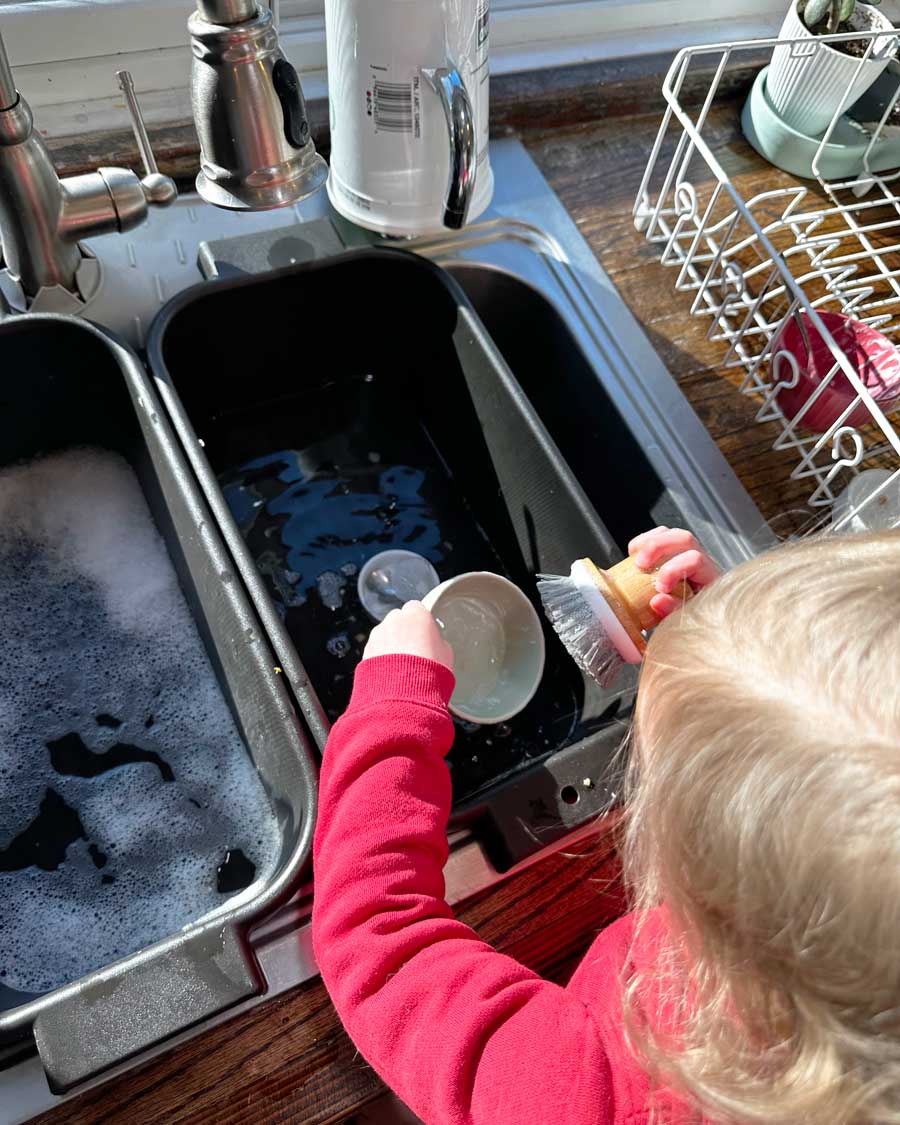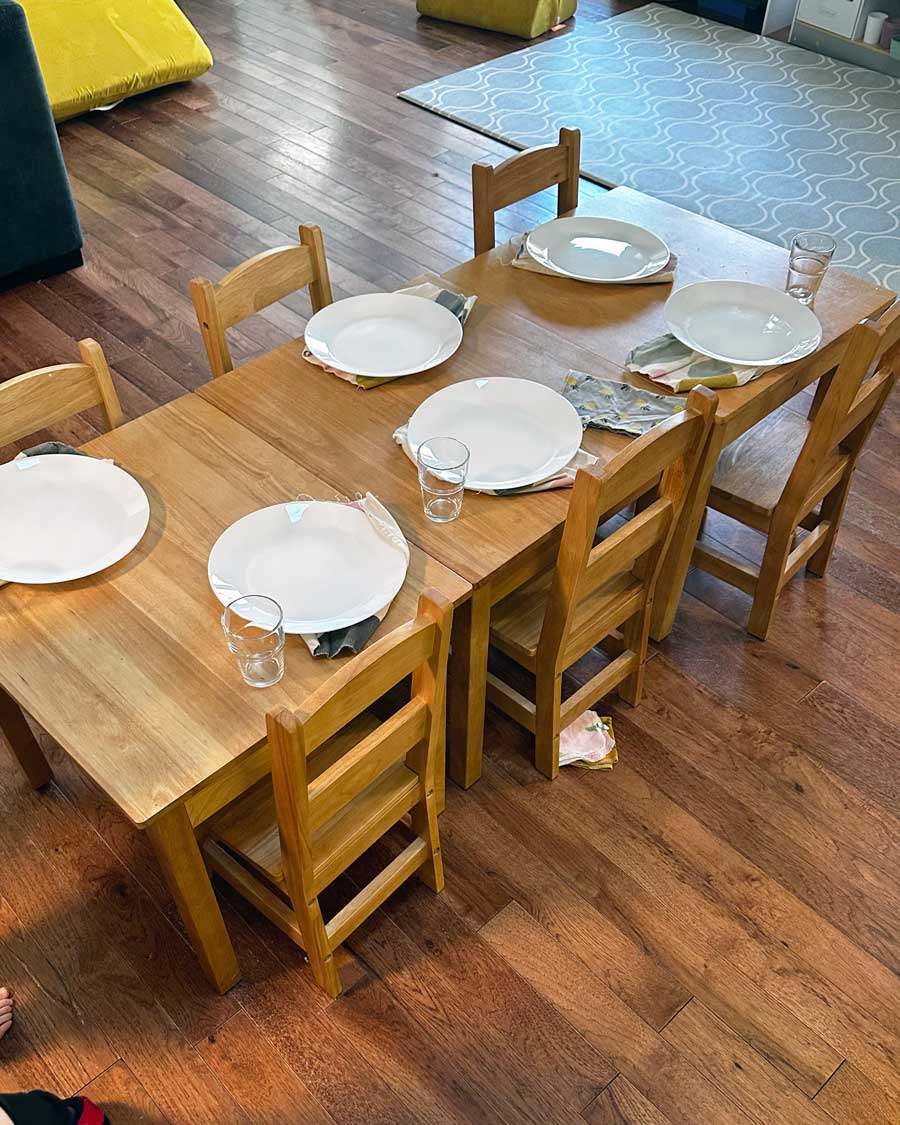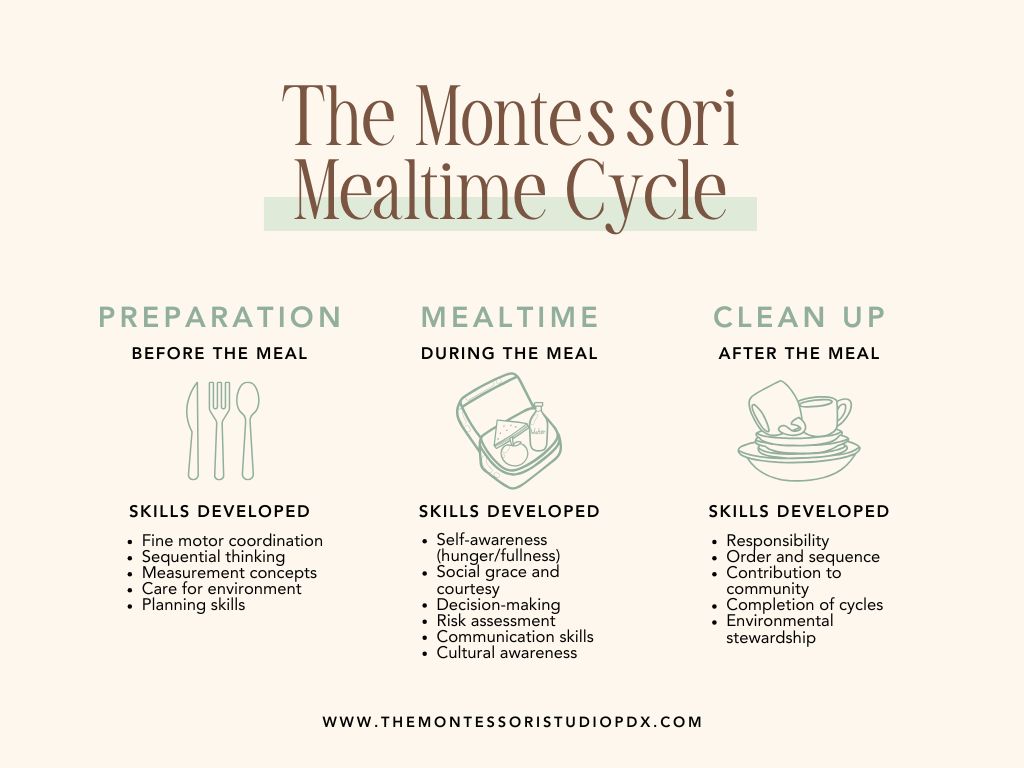
The first time most parents watch their three-year-old carefully pour water from a small glass pitcher into their cup at our Montessori school, they hold their breath. Would it spill? Would the glass break? To their amazement, they almost always complete the task with remarkable focus, and look up with unmistakable pride in their eyes.
That moment captures the heart of the Montessori philosophy for mealtime independence. It’s not just about feeding hungry children, it’s about creating opportunities for practical life skills, self-help development, and community building that happen to revolve around food.
If you peek into our classroom during lunch, you’ll notice something different from typical preschool cafeterias. Our Montessori mealtime environment features students setting actual tables with cloth napkins, ceramic plates, and real glassware – all essential components of practical life activities. The room hums with conversation as children serve themselves from shared platters and engage in natural social exchanges.
What often surprises visitors most isn’t just that young children use “breakable” items – it’s how capable they are when trusted with meaningful responsibility in our family-style meals.
“Wait, did that four-year-old just clear her entire place setting and wash her dish?”
Yeah, she did. And she’s been developing these food independence skills since she was three.
I get it. The thought of giving a preschooler real dishes makes many parents nervous. We’ve all seen toddlers drop plastic cups from their high chairs like they’re conducting gravity experiments.
So why do we use actual glass and ceramic in our Montessori kitchen setup?
When children handle real dishes, they naturally become more careful. There’s something about the weight, temperature, (and the potential consequences), that encourages mindful movement. A plastic cup can be thrown without much happening. A glass one teaches natural lessons about care and attention – cornerstone Montessori practical life skills.

Do things break? Of course. But that too becomes a valuable learning opportunity, not a disaster. When accidents happen, children help clean up without shame or punishment. The genuine disappointment of breaking something teaches more than any lecture about “being careful” ever could.
One mother recently told me how her daughter insisted on getting “a real glass like at school” at home. “I was terrified,” she confessed, “but my daughter treats that little juice glass with more care than anything else she owns. She even showed her little brother how to carry it with two hands!”
Grab our list of Montessori Kitchen Tools for Toddlers.
Watch a young child the first time they successfully serve themselves from a shared bowl. You’ll see concentration, developing coordination, decision-making, and ultimately, satisfaction. This simple act contains so much learning within Montessori food preparation activities.
Instead of pre-plated portions, our family-style meals allow children to:
I’ve watched countless picky eaters become more adventurous simply because they get to decide how much of that “suspicious new food” goes on their plate. A tiny spoonful of something new feels manageable when it’s self-selected – a key principle in teaching children mealtime independence.
In our Montessori classroom, children don’t just show up when food is ready. They’re involved in the entire process through age-appropriate food preparation activities:
Before meals: You’ll find children setting tables, cutting fruits for snacks, arranging flowers for centerpieces, and filling water pitchers with child-sized kitchen tools. These Montessori practical life preparations create anticipation and investment in the meal to come.
During the meal: Children serve themselves, pass dishes with “please” and “thank you,” and engage in genuine conversation. Our guides sit and eat with the children rather than hovering or serving – a fundamental aspect of Montessori at home mealtime approaches.
After eating: The real magic continues as children practice cleaning up after meals. They scrape plates, rinse dishes, wipe tables, and sweep floors. Rather than seeing these as chores, they view them as important contributions that bring genuine satisfaction.
As one child told me while proudly mopping a spill: “I’m taking care of our classroom because I love it here.” That sense of ownership and community responsibility starts with these simple Montessori mealtime activities for toddlers and preschoolers.

Our role as adults during Montessori mealtimes often surprises parents. Instead of constantly directing, reminding, and intervening, we:
This approach requires patience and sometimes biting your tongue when you see a child struggling with something you could easily do for them. But the look of accomplishment when they finally manage it themselves? Worth every extra minute.
| Aspect | Conventional Approach | Montessori Approach |
|---|---|---|
| Environment | • Plastic dishware • Pre-plated food • Child-specific seating • Adult-centered kitchen | • Real dishes and glassware • Shared serving dishes • Child-sized but real furniture • Accessible kitchen areas |
| Adult Role | • Server • Food enforcer • Problem solver • Center of control | • Model • Guide • Observer • Creator of opportunities |
| Child's Role | • Passive recipient • Following directions • "Clean your plate" • Dependent on adults | • Active participant • Making choices • Self-regulating portions • Building independence |
| Mealtime Focus | • Finishing food • Behavior management • Efficiency • Nutrition only | • Process of eating • Social connection • Skill development • Joy in contribution |
| Learning Approach | • Rules and expectations • External rewards/consequences • Rushed timeframes • Adult convenience | • Natural consequences • Intrinsic satisfaction • Unhurried pace • Respect for development |
| Materials Used | • Unbreakable items • Child-specific products • Disposable options • Adult manages materials | • Real, breakable items • Authentic tools scaled down • Quality, lasting materials • Child accesses independently |
You don’t need to transform your kitchen overnight. Small changes to your Montessori kitchen setup at home can make meaningful differences:
Start with one element that feels manageable. Maybe it’s a child-sized pitcher with just a little water for pouring practice. Or perhaps a special place in the kitchen with a small sponge so your child can participate in cleaning up after meals.
Create accessible spaces where independence can flourish. A low drawer with napkins and placemats allows your child to set the table without asking for help. A step stool by the sink makes handwashing and dish rinsing possible for little ones practicing Montessori food preparation.
Remember that learning is messy. Your child’s first attempts at serving spaghetti might leave sauce in surprising places. Keep cleaning supplies handy and approach messes as part of how to include toddlers in meal preparation.
Value effort over perfection. The napkins might not be perfectly folded, but your child’s pride in setting the table is what truly matters when implementing the Montessori approach to family dinners.
One parent in our community started small, just having her toddler place napkins at each seat before dinner. “Now,” she says, “he reminds ME that we need to set the table. He gets everything out and even reminds his older sister to wash her hands. Dinner prep has become a special time together rather than me rushing around while he whines for attention.”
Ever wonder when your child is ready to pour their own milk or help set the table? Our “Montessori Mealtime Milestones” guide takes the guesswork out of mealtime independence! This free printable resource breaks down age-appropriate tasks from 6 months through 6 years, complete with practical tips for success at each stage.
The practical skills children develop through Montessori mealtimes are valuable, but the internal growth is even more significant. Children who participate fully in caring for themselves and their community develop:
These qualities go far beyond the dinner table. They become part of how your child sees themselves in the world – the true essence of why Montessori uses breakable dishes and embraces family-style meals.
What small mealtime shift might bring more independence and joy to your family table this week? Remember, you don’t have to implement every Montessori mealtime activity at once. Even small steps toward including your child more meaningfully in mealtimes can spark remarkable growth.
And yes, there will be spills along the way. Keep a cloth handy—and remember that learning to clean up those spills is just as important as learning to prevent them in the Montessori approach to food independence.
Copyright © 2024-2025 The Montessori Studio | Site Crafted by Felicity Creative